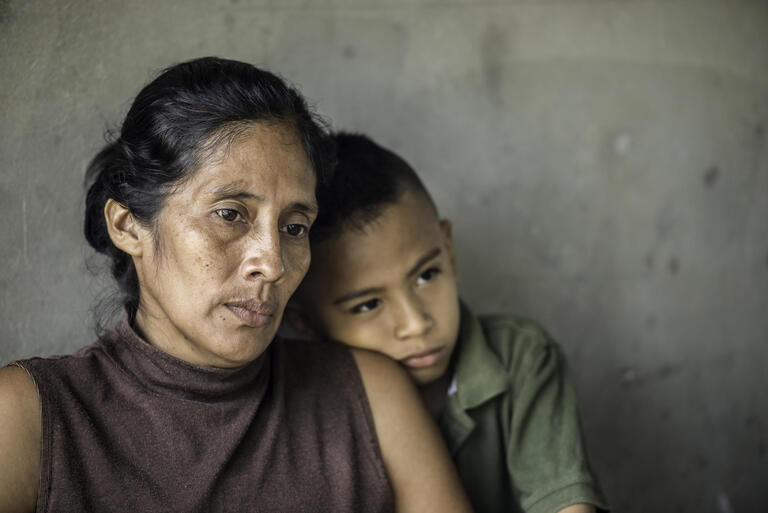
# 1 Organised crime forces people to flee
Criminal gangs exert heavy territorial control in urban areas in Central America, where poverty is rampant. In these areas, murders are reported every day, while extortion puts every small business owner at risk in some neighbourhoods. Girls and boys are at risk of recruitment, whereas women can experience intimidation and sexual violence as a means of control by gang members. Families under threat are coerced into abandoning their homes with no hope of return. Many flee their homes because of fear.
# 2 Murder rate declines, but violence persists
Although the murder rate remains high, the overall decrease in murder rates is a positive signal. In 2011, Honduras was dubbed the "murder capital of the world". In that year, the homicide rate stood at 86.5 per 100,000 inhabitants. Since then, the rate had fallen to 42 per 100,000 in 2017, less than El Salvador, which recorded a murder rate of 60 per 100,000. According to the Small Arms Survey’s report, of the five countries with the highest violent death rates in 2016 – Syria, El Salvador, Venezuela, Honduras, and Afghanistan – only two had armed conflicts.

# 3 Daily life is a constant battle
Endemic violence and crime have significantly compounded humanitarian needs in Guatemala, Honduras and El Salvador, known as the Northern Triangle of Central America. Close to three million people rely on humanitarian assistance, nearly ten per cent of the total population. A total of 667,000 people have been internally displaced in these three countries.
#4 Hide or flee in search of international protection
According to displaced people’s testimonies, internal displacement is often the starting point for a series of journeys with no end and no return in sight. Without adequate assistance and protection in their countries of origin, today’s internally displaced people become tomorrow’s refugees, asylum seekers or migrants. Because of a significant flow of people crossing borders and seeking international protection, the humanitarian crises of Honduras, Guatemala and El Salvador have acquired a regional dimension.
According to United Nations, eight out of every 100 new asylum applications in the world between January and June 2017 were from the Northern Triangle of Central America countries, despite them representing only 0,4 per cent of the world population. The recent Trump administration’s decision to further reduce the target for quota refugee admissions in 2019 from 45,000 to 30,000 will directly affect the protection of thousands of people from the North triangle of Central America.

#5 Risking deadly journeys
The physical distance between countries of origin and places of international protection poses a series of difficulties and extreme risks for those embarking on a journey to safety. Where transportation is unavailable, displaced people are often forced to walk long distances, use illegal routes and smugglers to take high-risk journeys.
These situations increase the risk of trafficking, extortion, forced labour, sexual violence and other abuses. A woman told NRC that after a couple of days travelling from Honduras to the US, she was ordered to get into an ice-cold container on a truck with many other people. She sat in the same uncomfortable position for seven hours with little air.
#6 Living on less than USD 1.90 a day
Nearly one in five Hondurans, Salvadorians and Guatemalans live on less than USD 1.90 a day. Most internally displaced people live in poverty and under continuous threat of violence and human rights violations. According to the World Bank, nearly 80 per cent of the population under the age of 15 in Honduras and El Salvador live in poverty.

#7 A dangerous place for women and girls
The Northern Triangle of Central America is one the most dangerous region for women. Seven of the ten countries with the world's highest murder rates for women are located in Central and Latin America. The Observatory of Violence at the National Autonomous University of Honduras estimated that at least one woman was murdered every 17 hours. Girls tend to experience threats, intimidation and sexual violence by gang members, as well as threats to their family members if they refuse to comply. The majority of cases remain unpunished.
#8 Schools are threatened
Criminal gangs have managed to infiltrate the core of educational establishments, influencing the decisions of principals and teachers. Gang members routinely promote the sale of drugs to minors, extort teachers and students, and carry out recruitment, surveillance and intelligence activities. Direct threats from criminal gangs have led to the closure of schools or cancellation of classes. As a result of the violence, children must transfer schools or abandon their education altogether. In Honduras, during June and July 2018, three attacks on schools were reported.

#9 Unable to protect all those displaced
Governments and humanitarian organisations do not have the tools or the capacity to respond to humanitarian and protection needs. Despite the recent progress to address displacement, there is no legal framework or any public policy in any of these countries that specifically focus on protecting and assisting displaced populations. So far, limited mechanisms have been established to provide protection and assistance.
#10 Humanitarian response is underfunded
Many donors in the region, while acknowledging the situation, are not able to fund a response as internal displacement is not part of their regional strategies. This makes it very challenging for humanitarian organisations to secure the resources required to meet the needs of women, children and youth who are affected by generalised violence. Humanitarian donors should prioritise funding to address the humanitarian situation in the Northern Triangle of Central America.




